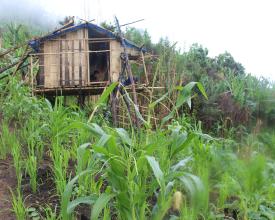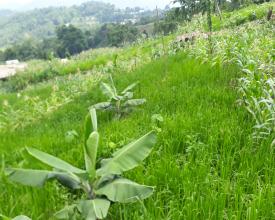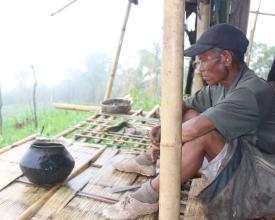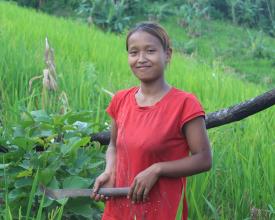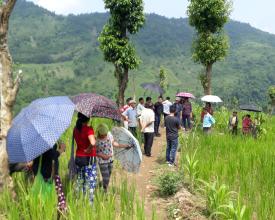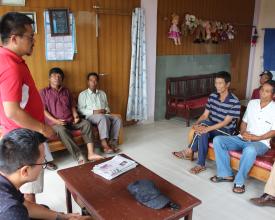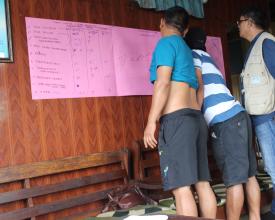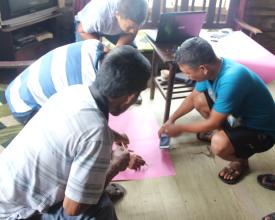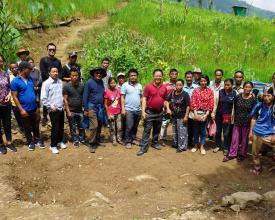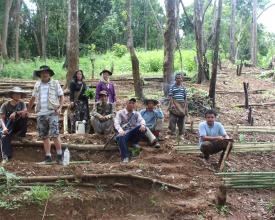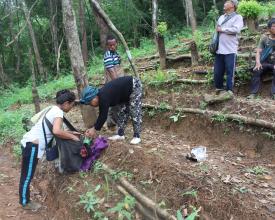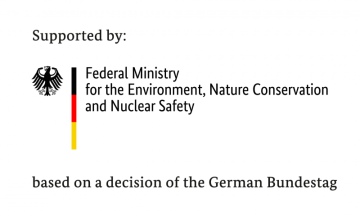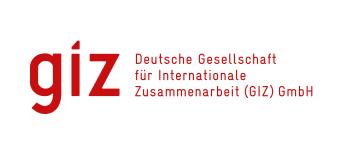Developing awareness and skills of the land users on measures of Jhum intensification & optimization in Mizoram, India
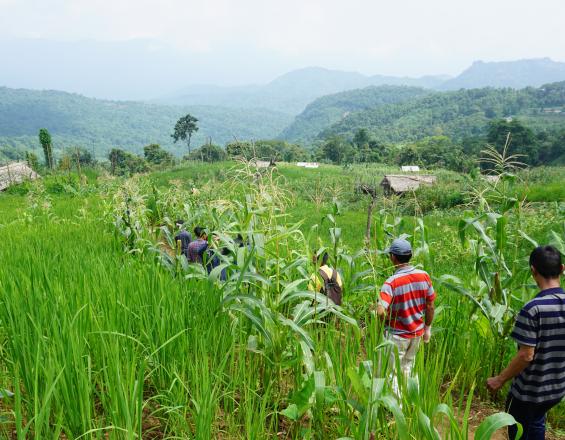
Jhum as a farming practice is mostly found in the North East India and it is the way of life and deeply embedded in the tradition and culture of the local communities of the region. However in the recent past due to changes in the socio-economic condition and land use pattern, shortcomings like reduced jhum cycles, reduced fallow period, loss in soil fertility and poor crop yields have started to emerge in the jhum field of Mizoram thereby threatening degeneration of the state's rich natural resource and well being of the community directly depending on them.
The IKI- Biodiv project has helped in generating awareness and strengthened the capacity of the land users on measures of jhum optimization and intensification which will contribute to promoting biodiversity and ecosystem services while ensuring food and livelihood security of the farmers.
Context
Challenges addressed
- Jhumming or the rotational agro forestry is the main landuse practice and the major source of food security and livelihood for the rural communities of Mizoram for centuries. This practice is well adapted to this region creating cultural landscapes and has been found to preserve biodiversity and forest on a long term.
- In recent years, jhum has come under stress due to land use changes, shortening of jhum cycle, reduced fallow period, loss of soil fertility and reduced crop yield.Therefore there is an urgent need to align various ecosystem services with the rapid soicio economic transformation taking place in Mizoram.
- Therefore to popularize the practice of jhum optimization and intensification by bringing in measures for increasing cultivation period i.e. fallow management to restore soil fertility, recharge soil moisture and underground water, creation of secondary forest and other subsidiary income as well as enhancing microbial actvities and maintain ecosystem were undertaken.
Location
Process
Summary of the process
- The first building block helped to address the knowledge gap of the local communities and land users by generating awareness about the importance of biodiversity conservation and its linkages to their livelihood and food security.
- The second building block made them to realize that the measures of jhum optimization are just some kind of improvisation of the method which they were already practicing and by observing them being practiced by their counterpart in Nagaland helped them
- to improve their knowledge,
- to gain confidence
- and to trigger practicing them back in their village. - After enhancement of their capacity, the third building block can effectively address the challenge, as the local community depends upon the forest and its resources for their livelihood and the need to conserve it by adopting various innovative practices of good jhuming.
- Finally the solution will provide an oppurtunity to convince the government for mainstreaming jhum optimization measures and incorporate this in their policy.
Building Blocks
Creating awareness through training and workshop
Inorder to create awareness on the measures of jhum optimization already being practiced by the farmers of Nagaland, a 2- days workshop was organised at project village for the community leaders , farmers and field functionaries of forest department. Although jhum was being practiced for generations by the villagers, they were not aware of the measures for jhum intensification and its optimization. Benefits of these measures in increasing their farm income and improving biodiversity and ecosystem services were explained through a participatory process and a power point presentation. Involving community leaders and community elders along with women and youth leaders in the training programme was an added advantage as this leveraged the urgency of the programme and its implementation .
Enabling factors
- Orientation of the jhum optimization measures to the state nodal agency i.e. the state biodiversity board and the village council members was key to win the confidence and trust of the stakeholders.
- Realization of the farmers and stake holders on the urgency of problem faced and willingness to actively participate and acquire knowledge and implement them in their own jhum.
- Selection of the beneficiary who is having plot in the current jhum field was an added advantage
Lesson learned
- Incentivising any programme in the village in form of inputs / exposure visit could generate interest among the community to actively participate.
- Participatory programme planning in the village along with the participants generated more interest and discussions
Enhancing Knowledge through Exposure visit
A weeklong exposure visit to Nagaland starting from 15-20 th of July 2019 was arranged for the farmers and community leaders of the village. During the exposure visit they were taken to the jhum fields and jhum optimization measures adopted by the Naga farmers was shown. Farmers to farmers’ interactions were also arranged, whereby the farmers got the opportunity to clarify their doubts. They were also taken to the State Agriculture Research Station (SARS) where research on jhum optimization measures are being carried out and interaction with the scientist gave them newer insights.
The exposure visit to Nagaland created an impact in understanding the methodology and benefits of improved practice in their jhum.
Enabling factors
- Nagaland has been adopting jhum optimization measures by which excellent result in increasing cropping intensity in the jhum field have been observed.
- A well planned tour itinerary was prepared and logistics for the travel were arranged well in adavance and the time of visit concided with active jhum season.
- The government authority in Nagaland was contacted before the journey explaining the purpose and details of the visit.
- The selection of the farmers for the visit were done keeping in mind involvement of community leaders, women and youth.
Lesson learned
The exposure visit created enthusiasm among the farmers and their confidence increased. The time of visit was perfect as all operations for jhum optimization could be observed in the field. Such visit provided an oppurtunity to exchange crop germplasm among the farmers and created a way for improving biodiversity conservation.
The most important lesson learned was that the exposure visit beside increasing knowledge act as a medium for building confidence and ties among the hill tribe practicing similar landuse and cropping pattern in the region.
Demonstrating measures for Jhum optimization
The demonstration of the Jhum optimization measures in the farmers field on pilot basis involving the community would show results which will convince the farmers how small modification on the present system of jhum management would make a difference in terms of conserving soil, increasing fertility level and improve soil moisture while increasing crop yield and improving eco system services.The outcome of the positive results would built their confidence and encourage the land users to adopt in larger area and finally incorporate them in their system in managing their jhum field.
Enabling factors
Building trust of the land users and the commnunity and also the lessons learned during the exposure visit to Nagaland was an added advantage as they could see by themseves the difference of practicing improved jhum.
The communities were already practicing the jhum system of farming and adopting few modification in management was not at all a problem to them.
Lesson learned
Regular interaction and focused discussions with the community and land users are a key component for any community based programme. Building trust with the village council and community leaders becomes important given the fact that the land and forest are governed by them and their decision becomes important in smooth function of the activities in the village.
The time for implementation of this building block is very important as this should start from the selection of jhum plot. In this case there was already crop in the jhum field and they could not be disturbed. Hence for demonstration a 100 sq meter plot was selected near the jhum field where the measures were undertaken.
Resources
Impacts
- Awareness on biodiversity conservation and ecosystem management was generated among the government official, community leaders and farmers.
- Interest among the farmers and community leaders to take up different jhum optimization measures in their jhum field was developed.
- The farmers started to conserve the forest tree seedlings and trees offshoots during weeding in their jhum field.
- The department of forest environment and wild life exhibited interest and was ready to asses the villagers with ready to plant tree saplings.
Beneficiaries
Village council members and farmers of Khawrihnim village in Mizoram were the main beneficiaries. Besides them a Self help group and government officials of forest department also benefitted from the programme.
Sustainable Development Goals
Story
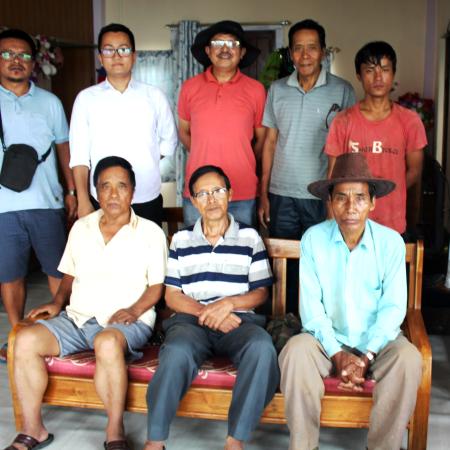
In Khawrihnim village the farmers were practicing Jhum for generations and cultivation of secondary crops, mixed and intercropping of oilseeds, pulses, vegetables, spices and tubers along with rice as the main crop were in the practice in the jhum field.Though the farmers were aware about the benefits of long fallow cycle and regeneration of forest, they were skeptical about the idea of continuing in the same Jhum plot in the second year as they feared drastic reduction of crop yield due to loss of soil fertility. Further, the village had never thought about it, as they were comfortable with utilizing the Jhum land only for a year as they had enough land in their disposal and presently their Jhum cycle was 9-10 years.
The village council authority and the farmers were convinced after the workshop that little modification in their existing jhum system through jhum optimization measures would benefit them immensely through increase in household income while conserving biodiversty and improving ecosystem service of the land users.


